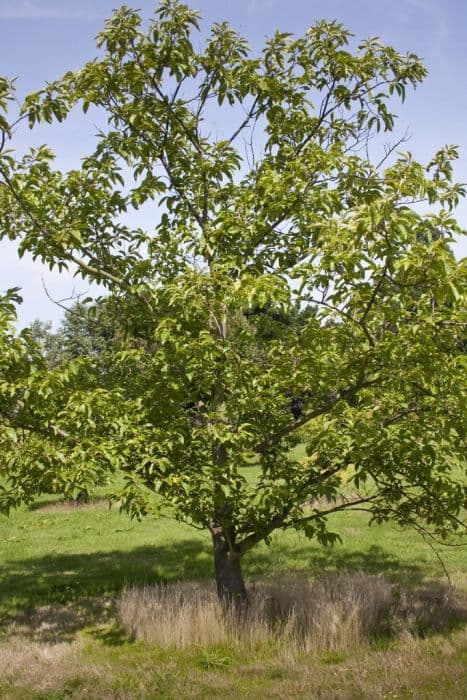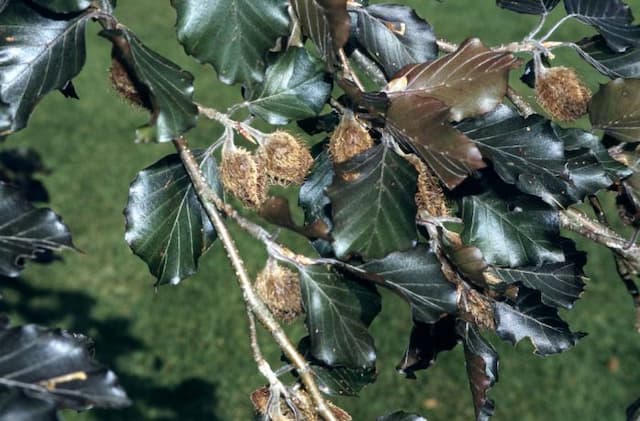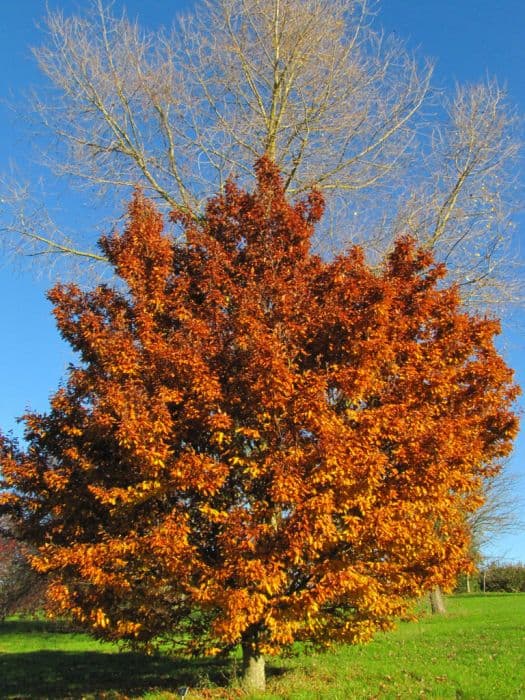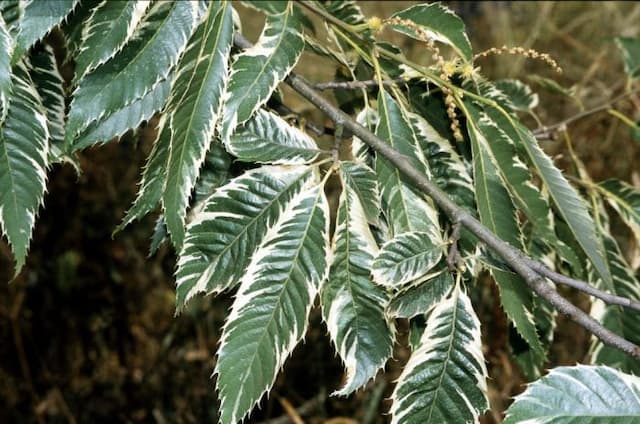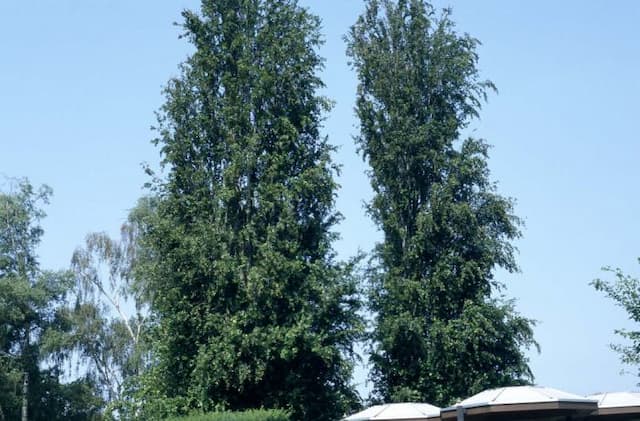Scarlet Oak Quercus coccinea 'Splendens'

ABOUT
The plant known as the Scarlet Oak 'Splendens' features a distinctive and impressive appearance. It is characterized primarily by its vibrant and showy foliage. During the spring and summer, the leaves are a rich green, deeply lobed with pointed tips, resembling the classic oak leaf silhouette. As autumn approaches, this foliage undergoes a spectacular transformation, turning a brilliant scarlet red, which is how the tree gets its common name. The leaves themselves are shiny and have a somewhat leathery texture, creating a dazzling display against the autumn sky. While the vibrant autumn colors are the most striking feature, this plant is also noteworthy for its attractive bark, which provides year-round interest. The bark is deeply furrowed, with ridges that develop a rough texture as the plant matures. Aside from the foliage and bark, in springtime, the Scarlet Oak 'Splendens' produces inconspicuous yellowish-green flowers, which later develop into acorns. These acorns are a food source for wildlife and contribute to the tree's ornamental value. The acorns have a classic shape, with a tough, woody cap that partially encloses the nut.
About this plant
 Names
NamesFamily
Fagaceae
Synonyms
Scarlet Oak, Splendid Oak, Splendens Scarlet Oak
Common names
Quercus coccinea.
 Toxicity
ToxicityTo humans
The Scarlet Oak is generally not poisonous to humans. Ingestion of large quantities of acorns or leaves can cause mild stomach upset due to the tannins present, but this is rare and typically not severe.
To pets
The Scarlet Oak can be mildly toxic to pets, especially dogs and cats if they consume large amounts of the acorns or leaves, due to the tannins. Symptoms of poisoning might include vomiting, diarrhea, and lethargy. In very rare cases, kidney damage could occur with substantial ingestion. It is always best to prevent your pets from consuming plant material from this oak to avoid any potential issues.
 Characteristics
CharacteristicsLife cycle
Perennials
Foliage type
Deciduous
Color of leaves
Green
Height
50-70 feet (15.24-21.34 meters)
Spread
40-50 feet (12.19-15.24 meters)
Plant type
Tree
Hardiness zones
4-9
Native area
North America
Benefits
 General Benefits
General Benefits- Ornamental Value: Quercus coccinea 'Splendens', commonly known as the Scarlet Oak, provides striking fall color with leaves turning a vibrant red, adding aesthetic beauty to landscapes.
- Shade Provision: Mature trees create significant shade, reducing summer cooling costs and creating comfortable outdoor spaces.
- Habitat Support: It offers a habitat and food source for wildlife, such as birds and squirrels, thanks to its acorns and structure.
- Soil Erosion Control: The Scarlet Oak's extensive root system helps to stabilize the soil, reducing erosion and improving water quality in nearby bodies of water.
- Longevity: Known for its long life span, the Scarlet Oak can provide benefits for several generations once established.
- Carbon Sequestration: Like other trees, it absorbs carbon dioxide from the atmosphere, helping to mitigate the effects of climate change.
 Medical Properties
Medical PropertiesThis plant is not used for medical purposes.
 Air-purifying Qualities
Air-purifying QualitiesThis plant is not specifically known for air purifying qualities.
 Other Uses
Other Uses- Woodworking Projects: Scarlet Oak wood is hard and dense, making it suitable for fine woodworking, including furniture and cabinetry.
- Tanning Leather: The bark tannins of Scarlet Oak can be used for the tanning of leather, though this is less common than with other oak species.
- Ink Production: Historical use of the galls from Scarlet Oak trees involved making ink, by combining the tannin-rich galls with iron salts.
- Natural Dye: The bark and leaves can be used to create natural dyes for textiles, with colors depending on the mordants used.
- Wildlife Habitat: The tree provides a habitat and nesting opportunities for various bird species, and the acorns are a food source for wildlife.
- Educational Tool: This oak is sometimes used in educational settings to teach about ecosystems and the importance of native tree species.
- Soil Improvement: Fallen leaves can decompose and contribute to soil health, adding nutrients and improving soil structure over time.
- Windbreaks: Due to its size and density, the Scarlet Oak is often used in windbreaks or shelterbelts to protect against soil erosion.
- Landscape Design: The attractive fall foliage of Scarlet Oak makes it a popular choice in landscape design for its seasonal interest.
- Cultural Significance: In some regions, the Scarlet Oak holds cultural significance and is planted in remembrance or to celebrate certain events.
Interesting Facts
 Feng Shui
Feng ShuiThe Scarlet Oak is not used in Feng Shui practice.
 Zodiac Sign Compitability
Zodiac Sign CompitabilityThe Scarlet Oak is not used in astrology practice.
 Plant Symbolism
Plant Symbolism- Strength: The Quercus genus, commonly known as oak trees, has been a symbol of strength and endurance due to its hard wood and long life span.
- Resilience: Scarlet oak, the common name for Quercus coccinea 'Splendens,' often represents resilience for its ability to withstand harsh conditions and still thrive.
- Nobility: Throughout history, the oak tree has been associated with nobility, with many royal families using its image in their crests or shields.
- Wisdom: Oaks are revered as wise due to their old age and longstanding presence, symbolizing knowledge and experience.
- Stability: As a robust and steadfast tree, the scarlet oak symbolizes stability and reliability.
 Water
WaterThe Scarlet Oak should be watered deeply once a week during its growing season, especially if there hasn't been substantial rain. It's crucial to allow the soil around the tree to dry out between watering sessions to prevent root rot. Young trees typically require about 10-15 gallons of water per week, depending on the weather conditions. During the dormant season or in cooler weather, water less frequently, monitoring the moisture level in the soil to guide you. Established Scarlet Oaks are drought-tolerant and may only need supplemental watering during prolonged dry spells.
 Light
LightScarlet Oaks require full sunlight to thrive, so the best spot for them is where they can receive direct sunlight for at least six hours a day. They do well in open spaces or areas with minimal shade interference, providing the intense light needed for proper growth and robust health. Avoid planting in shaded or partially shaded areas, as insufficient light can lead to poor foliage development and reduced vitality.
 Temperature
TemperatureScarlet Oaks are hardy and adaptable, making them suitable for a range of temperature conditions. They can survive minimum temperatures down to around -20°F and can handle the heat of summer well into the 90°F range. However, the ideal growing temperatures for optimal health and growth are between 60°F and 80°F. These trees are well-suited to temperate climates and can withstand seasonal temperature variations.
 Pruning
PruningPrune the Scarlet Oak to remove dead or damaged limbs, enhance shape, and improve air circulation. The best time for pruning is late winter to early spring before new growth begins. It's advisable to prune the tree every 2 to 3 years, focusing on removing only what is necessary. Pruning during the dormant season helps prevent the spread of disease and allows for easier observation of the tree's structure.
 Cleaning
CleaningAs needed
 Soil
SoilScarlet Oak prefers well-draining, acidic soil with a pH between 4.5 and 6.5. A mix of loam, sand, and organic compost is ideal to provide the necessary nutrients and drainage.
 Repotting
RepottingScarlet Oak trees, being large landscape trees, do not require regular repotting. Transplanting should be done in winter dormancy, only if necessary due to size or health.
 Humidity & Misting
Humidity & MistingScarlet Oak trees are adaptable to a wide range of humidity levels and do not require specific humidity conditions, thriving well in ambient outdoor humidity levels.
 Suitable locations
Suitable locationsIndoor
Scarlet Oak is not suitable for indoor growth due to its large size.
Outdoor
Plant Scarlet Oak in sunny spot with space to grow; water and mulch seasonally.
Hardiness zone
5-9 USDA
 Life cycle
Life cycleThe Scarlet Oak (Quercus coccinea 'Splendens') begins as an acorn, which, when conditions are favorable, germinates and grows into a seedling. As the seedling establishes its root system, it enters the sapling stage, where growth is rapid and the young tree develops its characteristic lobed leaves. Following the sapling stage, the Scarlet Oak enters the mature tree phase, characterized by a thickening trunk, elongated branches, and a broadening canopy. During its reproductive maturity, the tree flowers in the spring with male catkins and female flowers, leading to the production of acorns by autumn. These acorns are then disseminated by wildlife or gravity, which can result in new germinations. The Scarlet Oak can live for several hundred years, with older specimens entering a senescence phase where growth slows, and the tree eventually dies, decomposing to return nutrients to the soil.
 Propogation
PropogationPropogation time
Fall-Winter
The most popular method of propagating the Scarlet Oak, or Quercus coccinea 'Splendens', is through acorn seeding. The best time to collect acorns for propagation is in the fall, shortly after they have dropped from the tree. Preferably, acorns should be planted immediately since they lose viability quickly when stored. They need to be buried about 1 to 2 inches deep (2.5 to 5 cm) in well-draining soil and require consistent moisture to germinate. The planting site should be in a sunny location as Scarlet Oaks prefer full sun to thrive. It typically takes a month or two for germination to occur. Scarification of the acorns, which involves slightly damaging the outer layer to encourage germination, can be beneficial but is not always necessary.
